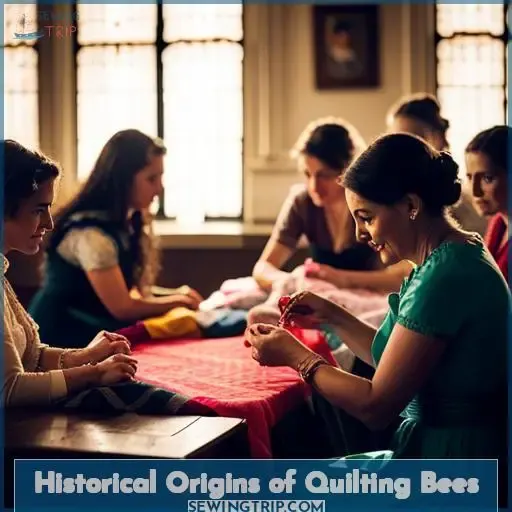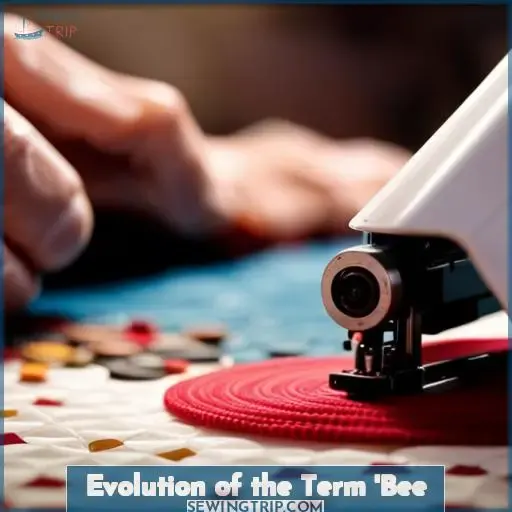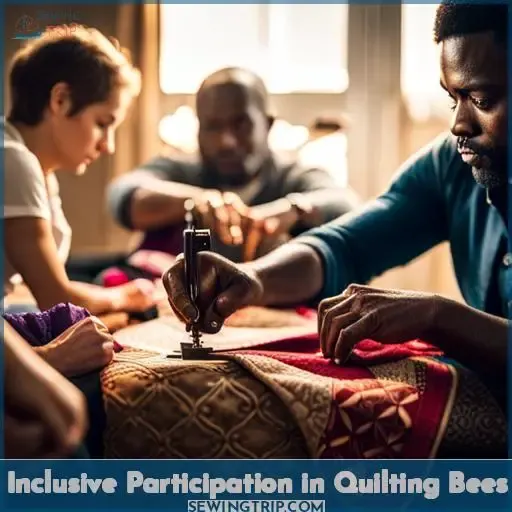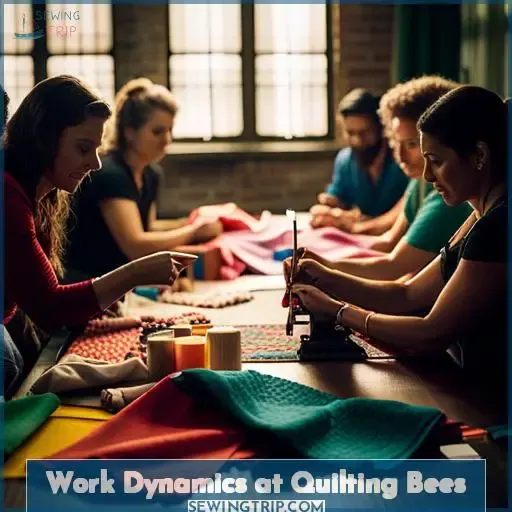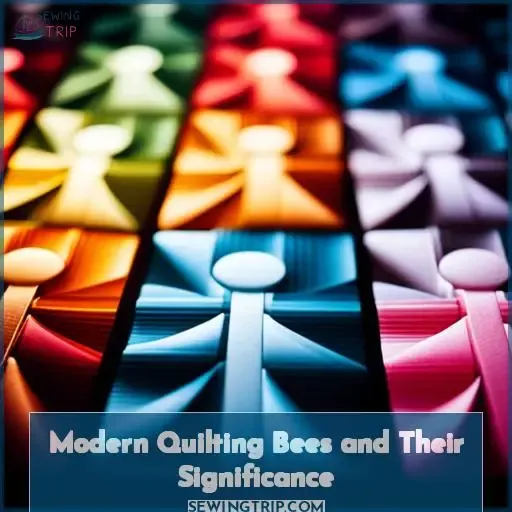This site is supported by our readers. We may earn a commission, at no cost to you, if you purchase through links.
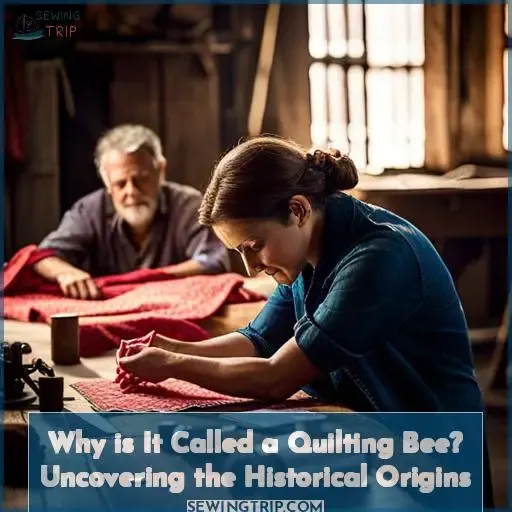 Uncover the fascinating history behind the term quilting bee, a gathering that has become synonymous with community, collaboration, and creativity.
Uncover the fascinating history behind the term quilting bee, a gathering that has become synonymous with community, collaboration, and creativity.
Discover how this unique event evolved from its colonial roots, where communal work was essential for survival, to its modern-day incarnation as a cherished tradition among quilting enthusiasts.
Explore the reasons why bee became the chosen descriptor for these gatherings, and delve into the dynamics of these events, where teamwork, skill-sharing, and camaraderie create a vibrant and empowering environment for all involved.
Table Of Contents
Key Takeaways
- Quilting bees emerged from colonial America’s communal work events, signifying a historical context of shared labor and cooperation.
- The term ‘bee’ was widely used in colonial America for various communal tasks, reflecting a cultural emphasis on collaborative traditions.
- The term ‘quilting bee’ gradually evolved to refer specifically to quilting gatherings, symbolizing the significance of communal labor in these events and becoming a powerful symbol of women’s empowerment.
- Modern quilting bees continue the tradition of communal labor, fostering community, providing learning opportunities, and promoting relaxation through skill-sharing, camaraderie, and the transformative power of collective effort.
Historical Origins of Quilting Bees
Quilting bees emerged from colonial America’s communal work events.
The term ‘bee’ was widely used for various tasks.
Over time, the term evolved specifically to refer to quilting gatherings.
This signifies the historical context of communal labor and cooperation in these social events.
Colonial America’s Communal Work Events
Let’s delve into the communal work events of colonial America, the birthplace of quilting bees.
These gatherings were a testament to the power of community bonding and the necessity of shared labor in a time of limited resources and geographic mobility.
Farmers, artisans, and neighbors came together for barn raisings, husking bees, and quilting parties, pooling their skills and resources to accomplish tasks that were beyond the capacity of a single household.
This spirit of cooperation and mutual aid laid the foundation for the quilting bee tradition, which continues to thrive today as a celebration of community and creativity.
The Term ‘bee’ and Its Historical Usage
In addition to being a social gathering, you’ll discover the term bee has historically been used in colonial America for various communal tasks like logging or husking.
This linguistic root extends beyond quilting, reflecting a cultural evolution where communal traditions took center stage.
| Task | Historical Context | Social Context |
|---|---|---|
| Quilting Bee | Nineteenth-century gatherings for collaborative quilt-making | Women’s sphere of influence, fostering community and skill-sharing |
| Logging Bee | Communal efforts to fell trees and prepare timber | Men’s domain, emphasizing physical strength and cooperation |
| Spinning Bee | Collaborative events for spinning yarn or thread | Both men and women participated, contributing to textile production |
These examples showcase the term bee as an integral part of colonial work, highlighting the importance of communal traditions and cooperation in shaping the social fabric of early America.
Evolution of the Term to Refer to Quilting Gatherings
As the term bee found its way into the lexicon of colonial America, it gradually shifted its meaning to specifically refer to gatherings centered around quilting, reflecting the significance of communal labor in these events.
This linguistic evolution symbolized a cultural adaptation, transforming the term bee from a general descriptor of cooperative work to a symbol of the unique and cooperative nature of quilting gatherings.
These shifts in language and societal connotations mirrored the changing roles of women in the 18th century, paving the way for the quilting bee to become a powerful symbol of women’s empowerment and solidarity.
Significance of Communal Labor in Quilting Bees
You’ll understand the profound significance of communal labor in quilting bees throughout history as we explore their origins.
Quilting bees were a testament to the power of collective effort, embodying the historical context of shared responsibilities and the cultural impact of communal work.
These gatherings fostered a unique labor dynamic, where individuals contributed their skills and talents to create something beautiful together, strengthening community bonds and promoting social evolution.
Quilting bees were more than just quilt-making sessions; they were social events that celebrated creativity, collaboration, and the transformative power of communal labor.
Evolution of the Term ‘Bee
You’ll discover how the term ‘bee’ went from describing various communal tasks to specifically referring to quilting bees.
This historical evolution reflects societal changes and needs, shedding light on the historical context of communal labor in colonial America.
Diverse Applications of the Term in Colonial America
Often in colonial America, you’d hear the term ‘bee’ used for different communal tasks, which included logging and husking.
This term’s versatility reflected the communal spirit and adaptability of colonial society.
Barn raisings, husking bees, and quilting bees showcased the diversity of communal labor.
The term ‘bee’ underwent a linguistic evolution, transitioning from general communal work to specifically refer to quilting gatherings.
This evolution mirrored the social shifts and changing needs of colonial communities.
Transition to Specifically Refer to Quilting Bees
You’ll find that over time, the term ‘bee’ narrowed down to specifically refer to quilting gatherings.
This transition mirrored the evolving social and cultural landscape of America.
Quilting bees embodied the spirit of cooperation, community, and shared creativity.
They transcended their practical purpose, becoming a symbol of unity and a platform for social interaction.
This transformation showcases the adaptability of language to reflect societal changes and cultural shifts.
Reflection of Societal Changes and Needs
Over the centuries, you’ve watched the term ‘bee’ adapt to reflect society’s changing needs and circumstances.
You’ve seen it morph from a general term for communal labor to a specific reference to quilting gatherings.
This evolution mirrors broader societal shifts, including changes in gender dynamics, cultural evolution, community spirit, economic implications, and societal adaptation.
The quilting bee, once a symbol of necessity, has transformed into an emblem of creativity, camaraderie, and shared purpose.
Historical Context of Communal Labor
As the term ‘bee’ evolved to specifically refer to quilting gatherings, it reflected the historical context of communal labor in colonial America. This communal tradition fostered cultural heritage, social bonding, and gender dynamics.
Quilting bees embodied the spirit of cooperation and mutual support, contributing to the fabric of colonial communities.
Artistic representations, such as Eliza Calvert Hall and Ruth Finley’s works, captured the essence of these gatherings, preserving their legacy for future generations.
| Historical Context | Cultural Significance | Artistic Representation |
|---|---|---|
| Communal Labor | Cooperation and Mutual Support | Eliza Calvert Hall’s Paintings |
| Gender Dynamics | Women’s Role in Quilting | Ruth Finley’s Illustrations |
| Social Bonding | Community Building | Quilting Party Depictions |
| Cultural Heritage | Preservation of Traditions | Historical Documentation |
| Artistic Representation | Capturing the Spirit of Quilting Bees | Paintings and Illustrations |
Inclusive Participation in Quilting Bees
Quilting bees historically welcomed both men and women, reflecting a sense of community.
Women typically handled the bulk of the labor, with men occasionally joining in.
Individual contributions and teamwork were essential, with teams sometimes competing against each other in quilting.
Participation of Both Men and Women
Frequently, both men and women were invited to quilting bees, reflecting a collaborative and inclusive approach to quilt-making.
This participation transcended traditional gender roles, fostering a sense of communal unity.
Men might aid in quilt construction, while women focused on intricate needlework.
Teams often formed, fostering friendly competition and showcasing the diverse talents within the quilting community.
Quilting bees celebrated the collective spirit, blurring gender lines in the pursuit of a shared artistic endeavor.
Traditional Expectations for Women’s Involvement
Carrying on from the inclusive nature of quilting bees, let’s delve into the traditional expectations for women’s involvement in these communal gatherings.
Historically, in North America, women were primarily responsible for quilt-making, a task viewed as an extension of their domestic duties. This gendered division of labor reflected the prevailing societal norms that assigned textile crafts to women’s domain.
Despite the collaborative nature of quilting bees, women’s contributions were often seen as an inherent part of their domestic responsibilities rather than a skilled craft.
Individual Contributions and Collaborative Efforts
You’ll find that both men and women contribute individually to different parts of the quilt, collaborating on a communal masterpiece.
Witness the fabric transformed by the nimble fingers of skilled artisans, each stitch a testament to their unique talents.
Teams emerge, their synchronized movements a symphony of creativity, competing against one another in a friendly rivalry that fuels their passion for the craft.
Quilting bees, a testament to the power of collective creation, continue to inspire and empower crafters, fostering a sense of community and artistic harmony.
Formation of Teams and Competition in Quilting
To encourage collaboration and friendly competition, quilting bees often involve the formation of teams. Participants work together on their quilts, fostering a sense of communal craftsmanship.
These teams leverage individual strengths, allowing quilters to contribute their expertise to distinct sections of the quilt. In some instances, quilting bees organize challenges, igniting friendly competition among teams as they strive to create the most intricate or visually stunning quilt.
This competitive spirit adds an extra layer of excitement and motivation, driving quilters to showcase their skills and creativity.
Reflection of Community and Shared Responsibility
Many quilting bees reflected a sense of community and shared responsibility.
Participants worked collaboratively to create intricate and beautiful quilts.
These gatherings reinforced community bonds, as neighbors and friends came together to support one another in completing a shared project.
Quilting bees exemplified cooperative creations and communal artistry, showcasing the power of teamwork and the value of shared craftsmanship.
Through these collaborative efforts, quilting bees strengthened the bonds of community and celebrated the traditions of teamwork.
Work Dynamics at Quilting Bees
At quilting bees, women assumed most of the labor, working collaboratively on different sections of the quilt.
Teams formed to increase efficiency and sometimes competed against each other, highlighting the importance of teamwork and cooperation in this communal activity.
Women’s Primary Role in Labor
Women were primarily responsible for the labor at quilting bees, collaboratively working on distinct sections of the quilt.
This work dynamic reflected the traditional gender roles of the time, with women expected to excel in domestic and textile arts.
Yet, within this context, quilting bees also provided a unique space for women’s empowerment and collaboration, fostering a sense of community and shared purpose.
Through their skilled hands and collective efforts, women played a vital role in preserving and passing down quilting traditions, while simultaneously challenging societal norms and contributing to the evolution of gender equality in quilting and beyond.
Collaborative Effort With Distinct Sections
Collaborative efforts at quilting bees involved dividing the work into distinct sections, allowing each participant to contribute their individual talents and skills.
This artistic collaboration fostered a sense of community crafting, where participants worked together to create something beautiful and meaningful.
Whether competing in quilting competitions or simply sharing in the cultural communion of the quilting bee, the collaborative effort highlighted the power of teamwork and the beauty of creating something together.
Efficiency and Competition in Team Formation
Efficiency’s union with competition drives the formation of teams during quilting bees, fostering a dynamic synergy that elevates the quilting experience.
Collaborative teams divide the quilt into sections, each team responsible for their own, promoting efficiency and ensuring a cohesive final product.
Yet, beneath the cooperative spirit, a friendly rivalry often emerges, with teams competing to complete their sections with the utmost precision and artistry, pushing each other to new heights of quilting excellence.
This harmonious blend of cooperation and competition epitomizes the transformative power of quilting bees, where tradition, creativity, and community converge to create a captivating spectacle of collaborative craftsmanship.
| Feature | Efficiency | Competition |
|---|---|---|
| Team Formation | Division of quilt into sections | Encourages friendly rivalry |
| Collaboration | Each team responsible for a section | Teams compete to complete sections with precision and artistry |
| Shared Goal | Cohesive final product | Pushes teams to new heights of quilting excellence |
| Outcome | Elevates quilting experience | Celebrates tradition, creativity, and community |
Value of Teamwork and Cooperation
To truly appreciate the work dynamics at quilting bees, it’s important to recognize the immense value of teamwork and cooperation that underpins these communal gatherings.
The collaborative nature of quilting bees fosters a sense of unity and shared purpose, where participants work together to create something beautiful and meaningful.
This cooperative creation exemplifies the power of communal craft, where shared labor and collaborative artistry produce stunning works of textile art.
The value of teamwork and cooperation in quilting bees extends beyond the practical benefits of efficiency; it embodies the spirit of community and the joy of creating together.
Modern Quilting Bees and Their Significance
Today’s quilting bees continue in crafting communities, adapting to virtual gatherings and integrating technology for skill-sharing and camaraderie.
They foster community, provide learning opportunities, and promote relaxation, making them a significant part of modern quilting culture.
Continuation in Contemporary Crafting Communities
Modern quilting bees thrive in today’s crafting circles, extending their legacy of collaboration and community.
Virtual quilting bees connect crafters globally, fostering skill-sharing and camaraderie beyond geographical boundaries.
Crafters of all ages blend their expertise in blended bees, creating a rich tapestry of techniques and perspectives.
Skill exchange programs empower participants to teach and learn, fostering a sense of accomplishment and mastery.
Adaptation to Include Virtual Gatherings
Quilting bees’ adaptation to virtual gatherings has broadened participation and fostered online communities.
Through the integration of technology, quilters are able to engage in remote creativity, connecting with fellow enthusiasts from all over the world.
These cyber beeing experiences provide a platform for virtual bonding and skill-sharing, enabling the exchange of quilting techniques through digital stitching.
Online quilting has revolutionized the traditional concept of quilting bees, creating a dynamic space for collaboration and connection in today’s digital age.
Diverse Participation and Integration of Technology
Today, you’ll find virtual quilting bees buzzing, drawing diverse crafters and integrating technology for collaborative projects.
Online quilting transcends geographical boundaries, uniting quilters of all ages and backgrounds. Intergenerational collaboration flourishes as seasoned quilters share their wisdom with aspiring ones.
Tech-infused bees leverage digital tools for pattern sharing, virtual skill-sharing sessions, and online quiltmaking challenges.
These modern quilting bees embody the spirit of innovation, fostering a vibrant and inclusive community connected by a shared passion.
Skill-sharing and Camaraderie Fostering Community
In modern quilting bees, you’ll find a welcoming environment for skill-sharing and camaraderie.
This fosters a sense of community among crafters.
Quilting traditions are revitalized as crafters gather to share their knowledge, techniques, and passion for the craft.
These gatherings provide a platform for crafters to connect, learn from each other, and form lasting bonds.
The social aspect of quilting bees nurtures a sense of community, offering a space for crafters to socialize, collaborate, and celebrate their shared passion.
Benefits of Learning, Discussion, and Relaxation
Besides fostering community, modern quilting bees offer avenues for learning new skills, discussing quilting trends, and simply relaxing in a shared, creative space.
Participants can expand their knowledge through skill swaps and workshops where experienced quilters share tips and techniques.
Trend talks provide an opportunity to stay up-to-date with the latest developments in the world of quilting.
Moreover, these gatherings serve as relaxation retreats where individuals can unwind while engaging in a beloved craft alongside like-minded enthusiasts.
Frequently Asked Questions (FAQs)
What is the significance of the term ‘bee’ in quilting bees?
The term bee in quilting bees signifies a communal gathering, emphasizing collaboration and teamwork.
It evokes a sense of unity and shared purpose, fostering a supportive environment for creativity and skill-sharing.
Join the quilting bee and harness the power of collective effort to create something extraordinary.
How did quilting bees evolve from practicality to a social event?
Quilting bees transformed from practical necessity to social gatherings as communities evolved.
Necessity stitches gave way to creative expression, fostering bonds and a sense of shared artistry.
What are some activities that take place at quilting bees?
Engage in collaborative quilting projects.
Hone your skills in workshops.
Delve into discussions on quilting trends.
Challenge yourself with thematic quilting endeavors.
How have modern quilting bees adapted to include virtual gatherings?
Modern quilting bees have adapted to virtual gatherings by weaving technology’s threads into their fabric.
Online platforms serve as virtual quilting circles, connecting enthusiasts from diverse corners of the world.
What are the benefits of participating in quilting bees?
Quilting bees offer a unique blend of learning, camaraderie, and relaxation.
Hone your skills, exchange techniques, and revel in the shared passion for quilting.
Join a bee and immerse yourself in a supportive community of fellow enthusiasts.
Conclusion
As the rhythmic hum of sewing machines fills the air, you become part of a living, breathing tapestry of history.
The quilting bee, a testament to community and creativity, weaves together past and present, reminding you that the essence of this gathering lies in its shared purpose and collaborative spirit.
Just as the stitches of a quilt unite disparate pieces into a cohesive whole, so too do these gatherings stitch together the fabric of our humanity.
In this space, you’re not just quilting; you’re quilting a bee, a symbol of unity, industry, and the enduring power of human connection.

